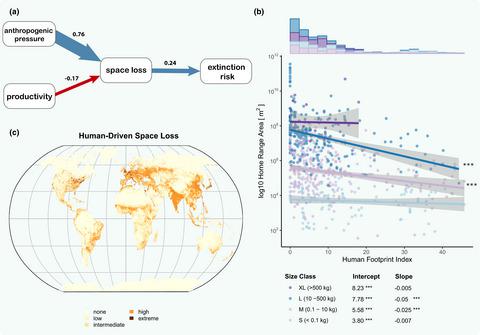当前位置:
X-MOL 学术
›
Ecol. Lett.
›
论文详情
Our official English website, www.x-mol.net, welcomes your
feedback! (Note: you will need to create a separate account there.)
Environmental and anthropogenic constraints on animal space use drive extinction risk worldwide
Ecology Letters ( IF 7.6 ) Pub Date : 2021-09-02 , DOI: 10.1111/ele.13872 Myriam R Hirt 1, 2 , Andrew D Barnes 3 , Alessandro Gentile 1 , Laura J Pollock 4 , Benjamin Rosenbaum 1, 2 , Wilfried Thuiller 5 , Marlee A Tucker 6 , Ulrich Brose 1, 2
Ecology Letters ( IF 7.6 ) Pub Date : 2021-09-02 , DOI: 10.1111/ele.13872 Myriam R Hirt 1, 2 , Andrew D Barnes 3 , Alessandro Gentile 1 , Laura J Pollock 4 , Benjamin Rosenbaum 1, 2 , Wilfried Thuiller 5 , Marlee A Tucker 6 , Ulrich Brose 1, 2
Affiliation

|
Animals require a certain amount of habitat to persist and thrive, and habitat loss is one of the most critical drivers of global biodiversity decline. While habitat requirements have been predicted by relationships between species traits and home-range size, little is known about constraints imposed by environmental conditions and human impacts on a global scale. Our meta-analysis of 395 vertebrate species shows that global climate gradients in temperature and precipitation exert indirect effects via primary productivity, generally reducing space requirements. Human pressure, however, reduces realised space use due to ensuing limitations in available habitat, particularly for large carnivores. We show that human pressure drives extinction risk by increasing the mismatch between space requirements and availability. We use large-scale climate gradients to predict current species extinction risk across global regions, which also offers an important tool for predicting future extinction risk due to ongoing space loss and climate change.
中文翻译:

动物空间使用的环境和人为限制导致全球灭绝风险
动物需要一定数量的栖息地才能生存和繁衍,而栖息地丧失是全球生物多样性下降的最关键驱动因素之一。虽然栖息地需求已通过物种特征和家庭范围大小之间的关系进行预测,但对环境条件和人类影响在全球范围内施加的限制知之甚少。我们对 395 种脊椎动物的荟萃分析表明,全球气候温度和降水梯度通过初级生产力产生间接影响,通常会减少空间需求。然而,由于可用栖息地的限制,特别是大型食肉动物,人类压力减少了实际空间使用。我们表明,人类压力通过增加空间需求和可用性之间的不匹配来推动灭绝风险。
更新日期:2021-11-11
中文翻译:

动物空间使用的环境和人为限制导致全球灭绝风险
动物需要一定数量的栖息地才能生存和繁衍,而栖息地丧失是全球生物多样性下降的最关键驱动因素之一。虽然栖息地需求已通过物种特征和家庭范围大小之间的关系进行预测,但对环境条件和人类影响在全球范围内施加的限制知之甚少。我们对 395 种脊椎动物的荟萃分析表明,全球气候温度和降水梯度通过初级生产力产生间接影响,通常会减少空间需求。然而,由于可用栖息地的限制,特别是大型食肉动物,人类压力减少了实际空间使用。我们表明,人类压力通过增加空间需求和可用性之间的不匹配来推动灭绝风险。











































 京公网安备 11010802027423号
京公网安备 11010802027423号